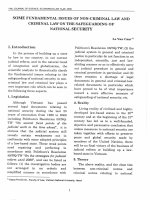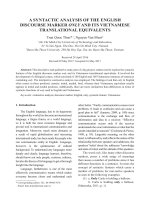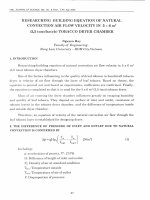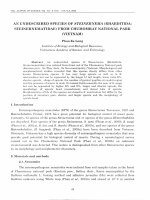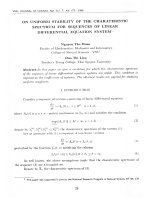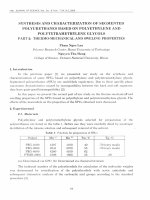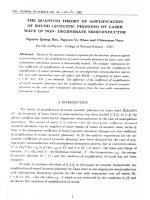DSpace at VNU: Local polynomial convexity of union of two graphs with CR isolated singularities
Bạn đang xem bản rút gọn của tài liệu. Xem và tải ngay bản đầy đủ của tài liệu tại đây (3.1 MB, 5 trang )
VNƯ Journal of Science, Mathematics - Physics 24 (2008) 6-10
Local polynomial convexity of union of two graphs with CR
isolated singularities
K ieu Phuong Chi*
Department o f Mathematics, Vinh University, Nghe An, Vietnam
Received 26 October 2007; received in revised form 4 December 2007
A b s t r a c t, We give sufficient conditions so that the union of two graphs with CR isolated
singularities in
is locally polynomially convex at a singularly point. Using this result and
some ideas in previous work, we obtain a new result about local approximation continuous
function.
1. In tro d u c tio n
We recall that for a given compact K in
by K we denote the polynomial convcx hull o f
K i.e.,
K = { z E:
\ \p{z)\ < \\p \\k for every p o ly n o m ial p in c ^ } .
We say that K is polynom ially convex i f K — K . A compact K is called locally polynomially convex
at a G
if there exists the closed ball B{ a) centered at a such that D { a ) n K is polynomially convex.
A smooth real manifold S' c
is said to be to ta lly real at a e 5 if the tangent plane Ts { a) o f
5 at a contains no com plex line. A point a € S' is not totally real that will be called a C R singularity.
By the result o f Wermer, if K is contained in totally real smooth subm anifolds o f
then K is locally
polynom ially convex at all point a ^ K (see [1], chapter 17). N ote that union o f two polynomially
convex sets w hich can be not polynomially convex set. Let z? be a small closed disk in the complex
plane, centered at the origin and
Ml ^ { { z, z) : 2: e - D} ; M2 = { ( z , z ^ ( p ( z ) ) : z e D } ,
where if is ã
function in neighborhood o f 0, (f{z) = o ( | 2:|). Then M l, M 2 are totally real(locally
contained in a totally real manifold), so that M l, M 2 are locally polynom ially convex at 0. The local
polynomially convex hull o f M l u M 2 is essentially studied by Nguyen Q uang Dieu (see [2,3]).
Let
= {{z,^) : z e D } , X 2 = {{z,^ + ^z)) :zeD},
where n > 1 is interger and (yơ is a
function in neighborhood o f 0, (fi{z) = o ( |z |” ). If n > 1 then
X \ and X 2 is not totally real at 0, so we can not deduce that X ị and X 2 are locally polynomially at 0
by the W erm er’s work. However, using the results about local approxim ation o f De Paepe (see [4;) or
the work o f Bharali (see [5]), we can conclude that X i and X 2 are locally polynom ially convex at 0.
In this paper, we will investigate the local polynomially hull o f X i L I X 2 at 0. The ideas o f proof takes
* E-mail:
Kieu Phuong Chi / VNU Journal o f Science, Mathematics - Physics 24 (2008) 6-10
from [2] and [3]. An appropriate tool in this context is K allin’s lemma (see [6,7]); Suppose X i and
Ẩ 2 are po lyn o m ia lly convex subsets o f C ” , suppose there is po lyn o m ia l p m a p p in g X i and X 2
in to two p o lynom ialhj convex subsets Y \ and Y 2 o f the com plex plane such th a t 0 is a boundary
p o in t o f both Y i and Y 2 and w ith Yi n >2 = {0}. / / p “ -(0) n (X i u X 2 ) is polynornially convex,
then X i u X 2 IS p olynom ially convex. Several instances o f such a situation, m otivated by questions
o f local approxim ation, were studied by O ’Farell, De Paepe and Nguyen Quang D ieu (see [8-10],...).
Let / be a continuous function on D . We denote that [z^, p ; D] is the function algebra which
consisting o f uniform limit on D o f all polynomials in 2 ^ and /^ . Using polynomial convexity theory,
it can be shown that [z^, p ] D] = C { D ) for some choices a
function / , w hich behaves like z near
the origin (see [9-11] ...)■ By the known result about approximation o f O ’Farrell, Preskenis and Walsh
[12] :i,f X is p o h jnom ially convex subset o f the real m a n ifo ld M , K is a com pact subset o f X
such th a t X \ K I S totally real. Then, i f f is co ntinuous fu n c tio n on X a n d f can be u n ifo rm
approxim ated by polynom ials on K then f can be u n ifo rm approxim ated by p o lyn o m ia ls on X ,
and the techniques developed in [13], we give a class function / which behaves like ^ such that
\f-D]:=C{D).
2. T he m a in results
We alw ays take the graphs X i and X
2
o f the form (*). For each r > 0 we put
= X i n {(z, ti)) : 1^1 < r} ,
1
=
1
,2.
N ow vvc come to the main results o f this paper.
T h eo rem 2.1. Let r n ,n he positive integers with rn > n. Let ip be a
fu n ctio n which is defined
near 0 o f the fo rm
ip{z) =
where f { z ) is a
0
z = 0,
fu n ctio n and f { z ) = o(l-sl"*). Suppose that there exists I < f
ai
such that
(1)
ak
k^l
and
is integer. Then X ị U X
2
is locally polynom ially convex at 0.
Proof. C onsider the polynomial p (z , w ) =
■^^m- 21 +n _|_
2 i+n belongs to real axis and
—_m —2í-Ị-n
p{X 2) = az
— _m —2/H-n ,
From p { X i ) = 0 2 " " '^ '+ " +
m —2/+n
w ith a choose later. Thus p { X i ) =
+
+CO
+ a (z "+ ^
a k Z ^z^-^ + f { z ) ) ^ + ^ =
k=—oo
^
+
01
+ 1 ) ^ - 2; y
71
+ o{\zr).
,^^
k=—oo
€ R , we obtain
9/
Im p ( X 2 ) =
^
^
k=-ooI
+ o d z D ).
__
Kieu Phuorìg Chi / VNU Journal o f Science, Mathematics - Physics 24 (2008) 6-Ì0
C h o o se
a
=
27% . It fo llo w s that
i m p { X 2 ) > |^|2—
> 0
(2 )
k^i
for any z 7^ 0 in a small neighborhood o f 0, by (1). It implies that p { X 2 ) n R ^ {0}. On the other
hand, from the inquality (2) we see that
p - ' ( 0 ) n X 2^ = { 0 }.
It is elm entary to check that
p “ ^(0) n X I = {{pex.p{i9), p"^exp{-niO)) : 0 <
< r},
with a constant 9. Obviously,
p - '( 0) n x [
is p o ly n o m ia lly c o n v e x for r sm all enough. T h u s p ~ ^ ( 0 ) n ( X [ U X 2 ) is p o ly n o m ia lly c o n v e x fo r r sm all
enough. By K allin ’s lemma (mentioned in introduction) we conclude that X I u X
convex for r sm all enough. The proof is completed.
2
is polynom ially
R e m a rk . 1) In the Theorem 1 we can replace X i by
X{ = { { z X - ^ i z ) ) : z E D } .
Then, as p in T heorem 1 we obtain the estimate
ĩm p ix ị)
<
0,
for any 2: / 0 in sm all neighborhood o f 0. On the other hand p~ ^(0) n (X 'ỵ u x ^ ) = {0} for r small
enough. By K allin ’s lemma we may conclude that X Ị u X 2 is locally polynom ially convex.
2)
This result includes the more restricted case n = 1 that is studied by N guyen Q uang Die
(see [2]).
The follow ing Proposition shows that if we replace i > y we may get nontrivial hull o f X [ U X 2 .
P roposition 2.2. Lei n , p be positive integers and
= {(2, 2") ■.z e D ) - X 2 =
-.zeD).
Then X i u X 2 is not locally polynom ially convex at 0.
Proof. For each t > Q , let Wi = {{z, w) : z ^ w — t}. Consider the sets
Pt : = Wt n
= { { z , r ) : \z\ = t ầ } -
Qt : = VKi n X2 = {(2, z” + zPz^+P) : 1^1 = s},
where s is unique positive solution o f the equation
+ s 2p+ 2n _ ị
gy
maximum modulus
principle we see that the hull of X Ị u
will contain an open subset o f Wt bounded by tw o closed
curves Pị and Qt for any Í > 0 small enough and hence X i u X 2 is not locally polynom ially convex
at 0 .
Kicu Phiiong Chi / VNV Journal o f Science, Mathematics - Physics 24 (2008) 6-Ỉ0
T heorem 2.3. Let m be a posiiive even integer and let n be a odd integer such that m > n. Let g
be a
function which is defined near 0 o f ihe fo rm
9Ì^) =
0
z =
0
,
where f is a c ’ fu n c tio n and f { z ) = o ( | 2:|"^). Suppose that there exists I such that
is positive
integer and
a ; l > ^ |a / c |.
k^i
Then the functions
(3)
and g'^{z) separate points near 0. Morever: [z^,g'^-,D] = C { D ) fo r D sm all
enough.
We need the next lemma (see [7,8]) for the proof o f Theorem 2.1.
L em m a 2.4. Let X be a com pact subset o f c ^ , and let TĨ \
be defined by tt{z , w ) =
{ z ' ^, w^ ) . Lei TT~^{X) = X u u ... u Xk i u ...
with X m n compact, and X k i = {{p'^z, t'-w ) :
{ z , w) e Xrr^n} f o r I < k < m , 1 < I < n, where p = exp
and T = exp
If
P ( ^ - 1 (X )) = c '(7 r-i (X )), then P { X ) = C { X ) .
P ro o f o f Theorem 2.3. First we show that the functions
and g'^iz) separate points near 0. Clearly
points a and b w ith a Ỷ - h are separated by z^. Now assume that g'^{z) takes the same value at a
and —a for some a ^ 0. Set
h( z ) =
z =
0
0
,
it follows that h( a) = - h { - a ) . As m is even, we have
aka a
2^
-/(a )-/(-a )
= ---------- ----------- .
k= —oo
D ividing both sides by
'a ' we obtain
kỹíl
a‘
By the inequality (3) and the fact that f { z ) = o ( |z p ) , we arrive at a contradition if we choose the
disk D sufficiently small.
N ext vve consider for a small closed disk D the set X w hich is the inverse o f the compact
X = { ( 2 ^, g'^{z) ; 2 E D } under the map ( 2 , w ) ^ (z^, w"^). We have X — X i U X 2 u A'3 U X 4 where
X , = {{z,T + h{z)):zeD};
X
2
= { ( - z , - 2 " - h{z)) : z € Ơ } = { { z , r - h { - z ) ) : z G D} X, = { { - z X + h{z))):zeDy,
X
4
= {{z, - z " - h{z) ) : z e D } = { ( - z , z" - h { - z ) ) : z € -D};
Kieu Phuong Chi / VNU Journal o f Science, Mathematics - Physics 24 (2008) 6-Ỉ0
10
By Rem ark ]), X ị U X
2
is polynomially convex for D small enough . We have X s u X
o f X i U J ^ 2 u n d er the b ih o lo m o rp h ic m ap
{z ,w )\-^
{-z ,w ).
4
is the image
S 0 X 3 U X 4 is also p o ly n o m ia lly c o n v e x
w ith D sufficiently small.
Now we consider the polynomial q { z , w) = z ^ w . Then q maps X i u X 2 to an angular sector
situated near the positive real axis, while p maps X 3 U X 4 to such sector situated near the negative real
axis. The sectors only meet at the origin. A pplying K allin’s lemm a w e get X ^
u X2 u X3 u X4
is polynom ially convex with D small enough. Furthermore, notice that X \ {0} is totally real (locally
contained in a totally real manifold), by an approximation theorem o f O T a ư e ll, Preskenis and Walsh
(mentioned in introduction), we get that every continuous function on X can be uniformly approximated
by polynomials. By the Lemma 2.4, we see that the same is true for X , which is equivalent to the
fact that our algebra equals C{ D) .
A cknow ledgem ents. The author is greatly indebted to Dr. Nguyen Quang Dieu for suggesting the
problem and for m any stim ulating conversations.
R eferences
[1] 11. Alexander, J. Wermer, Several Complex Variables and Banach Algebras, Grad. Texts in Math., springer-Verlag, New
York, 35 (1998).
[2] Nguyen Quang Dieu, Local polynomial convexity of tangcntials union o f totaliy real graphs in c ^ , ỉndag. Math., 10
(1999) 349.
[3] Nguyen Quang Dicu, Local hulls of union of totally real graphs lying in real hypcrsurfaces, Michigan Math. Journal,
47 (2) (2000) 335.
[4] P.J. de Paepe, Approximation on a disk I, Math. Zeit., 212 (1993) 145.
[5] G. Bharali, Surfaces with degenerate CR sigularities that arc locally polynomially convcx, Michigan Math. Journal., 53
(2005) 429.
[6] E. Kallin, Fat polynomially convex sets, Function Algebras, (Proc. Inter. Symp. on Function Algebras, Tulane Univ,
1965), Scott Foresman, Chicago, (1966) 149.
[7] RJ. de Paepe, Eva Kallin’s lemma on polynomial convexity, B ull o f London Math. Soc., 33 (2001) 1.
[8] Kieu Phuong Chi, Function algebras on a disk, VNU Journal o f Sciences, Mathematics - Physics No3 (2002) 1.
[9] Nguyen Quang Dieu, P.J. de Paepe, Function algebras on disks, Complex Variables 47 (2002) 447.
[10] Nguyen Quang Dieu, Kieu Phuong Chi, Function algebras on disks II, Indag. Math., 17 (2006) 557.
[11] P.J. de Paepe, Algebras of continuous functions on disks, Proc. o f the R. Irish. Acad., 96A (1996) 85.
[12] A.G. O T aưell, K.J. Preskenis, Uniform approximation by polynoimials in two functions, Math Ann., 284 (1989) 529.
[13] A.G. O ’Farrcll, PJ. de Pacpe, Approximation on a disk n, Math. Zeit., 212 (1993) 153.
[14] Kieu Phuong Chi, Polynomial approxiamtion on polydisks, VNƯ Journal o f Sciences, Mathematics - Physics No3 (2005)
11.
[15] A.G. OTarrell, K.J. Preskenis, D. Walsh, Holomoq^hic approximation in Lipschitz nomis, Contemp. Math., 32 (1984)
187.

